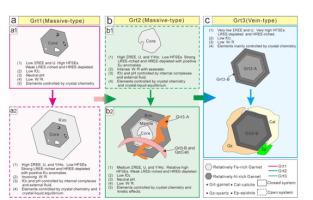Ore Geology Reviews ( IF 3.3 ) Pub Date : 2021-01-20 , DOI: 10.1016/j.oregeorev.2021.104004 ZhiYuan Sun , JingBin Wang , YuWang Wang , LingLi Long

|
Three generations of garnets are distinguished in the Yamansu volcanic-hosted skarn iron deposit in NW China, and their detailed textures and geochemical characteristics are presented to reveal the mechanisms controlling the distribution of trace elements in the garnets and to discuss the physicochemical conditions and evolution of the ore-forming fluid. First-generation garnets (Grt1) show well-preserved core–rim growth zonation and have considerable variations in composition (And25-99Gro0-73). Second-generation garnets (Grt2) show complex core–mantle–rim zonation textures with high andradite components (And54-99Gro0-44). Third-generation garnets (Grt3) occur in veins and exhibit nearly monotonic textures and geochemical components (And48-51Gro46-49). Garnet crystals in different generations have variable trace element compositions, such as REEs, U, and Y. We speculate that Grt1 cores were derived from a magmatic–hydrothermal fluid and crystallized in a closed system with low water/rock (W/R) ratios, low oxygen fugacity, and neutral pH, with the distribution of trace elements in Grt1 cores being largely controlled by crystal chemistry. However, during the crystallization of Grt1 rims and Grt2 cores, the hydrothermal fluid system is interpreted to have been open with high W/R ratios and with internal complexes (Cl complex) and external fluid (seawater-like) integrally controlling the fluid properties. The incorporation of trace elements into the Grt1 rims and Grt2 cores was controlled by not only crystal chemistry but also crystal-liquid equilibrium. The Grt2 mantles and rims are interpreted to have formed in a closed system as a result of crack-seal fluid flow. The inferred stable conditions associated with low W/R ratios, a reducing environment, and nearly neutral pH favored Fe reduction in the hydrothermal fluid and provided a material basis for later deposition of iron ores. Grt3 likely formed under near-equilibrium chemical conditions, with low W/R ratios during periods of slow fluid influx determined by episodic supply of hydrothermal fluids, and their distributions were largely controlled by crystal chemistry. The special environment of multistage hydrothermal fluid in the Yamansu deposit was the key factor controlling the multiple enrichment and precipitation of trace elements into garnet.



























 京公网安备 11010802027423号
京公网安备 11010802027423号